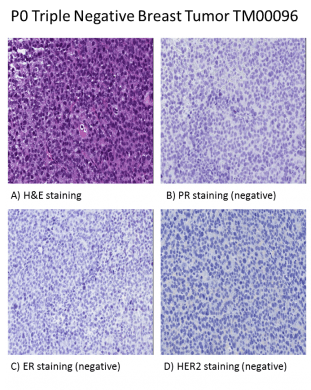1. What is a triple-negative breast cancer?
Triple-negative breast cancers (TNBCs) are breast tumors that do not express the hormone receptors for estrogen (ER) or progesterone (PR), or the HER2 protein (a member of the epidermal growth factor receptor family) on their cell surfaces. Triple-negative breast cancers tend to grow and spread more quickly than most other types of breast cancer. Clinically, TNBCs have relatively high rates of recurrence and distant metastasis, and patients have a poor overall survival prognosis.
2. Why don’t triple negative breast cancers respond to therapies that succeed for other breast tumor subtypes?
Because TNBCs lack ER and PR receptors they do not respond to hormonal therapies, such as tamoxifen or aromatase inhibitors. Similarly, they do not respond to therapies that target the HER2 protein, such as Herceptin (chemical name: trastuzumab). This limits treatment options. Although there are a number of potential therapies under investigation that may improve outcomes in TNBC patients, there currently is no proven, single agent with demonstrated efficacy against different types of TNBCs.
3. What are the latest mouse models to understand and test candidate drugs to treat TNBC?
 For several decades researchers have studied TNBCs using cultured tumor cell lines. This approach has limitations because the cells that grow in the animal host don’t adequately recapitulate the complexities of the tumorigenic process or the heterogeneity of the cells present in human tumors.
For several decades researchers have studied TNBCs using cultured tumor cell lines. This approach has limitations because the cells that grow in the animal host don’t adequately recapitulate the complexities of the tumorigenic process or the heterogeneity of the cells present in human tumors.
Patient-derived xenograft (PDX) models, on the other hand, resemble much better not only the tumor structure, but also gene-expression patterns, copy number variations, and the patient tumor’s response to anticancer treatments.
The figure right illustrates the first passage (P0) of a tumor derived from a 45-year- old Hispanic woman with a diagnosis of a non-metastatic Grade III triple-negative ductal breast cancer (T1N1M0) after engraftment into NSG mice. The beauty of this system is that by engrafting the tumorigenic cells in the context of their microenvironment, the xenografts closely resemble the patient’s tumor, and the engrafted mice can be considered surrogate patients or avatars.
4. How close are we to using mice to test which treatment will work best for a particular patient?
More and more, PDX models are contributing to the personalized selection of existing anticancer treatments. The driving factor is the improved predictability of efficacy that candidate drugs show when administered to patients in the clinic following demonstrated efficacy in vivo in pre-clinically engrafted mice.
This approach offers clear advantages to both patients and clinicians, because different candidate drugs can be tested for efficacy in mice engrafted with the patient’s tumor without subjecting patients to treatments that may prove ineffective in stopping or remitting their particular cancer.
5. How long does it take to use PDX models to decide the ideal therapeutic approach to revert tumor growth in a specific patient?
Several groups of oncologists are using PDX models in small-scale preclinical studies to decide which drug or combination of drugs has the best chance of resulting in tumor remission in the patient. Because growth of specific human tumors in mice can take several months, these studies typically take place while the patient is being treated with standard drugs.
